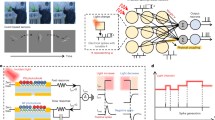Abstract
Computation with spiking neurons takes advantage of the abstraction of action potentials into streams of stereotypical events, which encode information through their timing. This approach both reduces power consumption and alleviates communication bottlenecks. A number of such spiking custom mixed-signal address event representation (AER) chips have been developed in recent years.
In this paper, we present i) a flexible event-driven platform consisting of the integration of a visual AER sensor and the SpiNNaker system, a programmable massively parallel digital architecture oriented to the simulation of spiking neural networks; ii) the implementation of a neural network for feature-based attentional selection on this platform.
Access this chapter
Tax calculation will be finalised at checkout
Purchases are for personal use only
Preview
Unable to display preview. Download preview PDF.
Similar content being viewed by others
References
Knudsen, E.: Fundamental components of attention. Annu. Rev. Neurosci. 30, 57–78 (2007)
Van Rullen, R., Thorpe, S.J.: Rate coding versus temporal order coding: what the retinal ganglion cells tell the visual cortex. Neural Comput. 13(6), 1255–1283 (2001)
Lichtsteiner, P., Posch, C., Delbruck, T.: A 128x128 120dB 15us Latency Asynchronous Temporal Contrast Vision Sensor. IEEE J. Solid State Circuits 43, 566–576 (2008)
Lenero-Bardallo, J.A., Serrano-Gotarredona, T., Linares-Barranco, B.: A 3.6 us Latency Asynchronous Frame-Free Event-Driven Dynamic-Vision-Sensor. IEEE Journal of Solid State Circuits 46(6), 1443–1455 (2011)
Sonnleithner, D., Indiveri, G.: A Neuromorphic Saliency-Map based Active Vision System. Neuroinformatics, 1–6 (2011)
Indiveri, G., Linares-Barranco, B., Hamilton, T.J., Van Schaik, A., Etienne-Cummings, R., Delbruck, T., Liu, S.C., Dudek, P., Häfliger, P., Renaud, S., Schemmel, J., Cauwenberghs, G., Arthur, J., Hynna, K., Folowosele, F., Saighi, S., Serrano-Gotarredona, T., Wijekoon, J., Wang, Y., Boahen, K.: Neuromorphic Silicon Neuron Circuits. Front. Neurosci. 5 (2011)
Wijekoon, J.H.B., Dudek, P.: VLSI circuits implementing computational models of neocortical circuits. J. Neurosci. Meth. (2012)
Furber, S., Brown, A.: Biologically-Inspired Massively-Parallel Architectures - Computing Beyond a Million Processors. In: 2009 Ninth International Conference on Application of Concurrency to System Design, ACSD 2009, pp. 3–12. IEEE, Washington, DC (2009)
Serrano-Gotarredona, R., Oster, M., Lichtsteiner, P., Linares-Barranco, A., Paz- Vicente, R., Gomez-Rodriguez, F., Camunas-Mesa, L., Berner, R., Rivas-Perez, M., Delbruck, T., Liu, S.C., Douglas, R., Hafliger, P., Jimenez-Moreno, G., Civit Ballcels, A., Serrano-Gotarredona, T., Acosta-Jimenez, A.J., Linares-Barranco, B.: CAVIAR: a 45k neuron, 5M synapse, 12G connects/s AER hardware sensoryprocessing-learning-actuating system for high-speed visual object recognition and tracking. IEEE Trans. Neural. Netw. 20(9), 1417–1438 (2009)
Davies, S., Patterson, C., Galluppi, F.: Interfacing Real-Time Spiking I/O with the SpiNNaker neuromimetic architecture. AJIIPS 11(1) (2010)
Davison, A.P., Bruderle, D., Eppler, J., Kremkow, J., Muller, E., Pecevski, D., Perrinet, L., Yger, P.: PyNN: A Common Interface for Neuronal Network Simulators. Front. Neuroinform. 2 (2008)
Galluppi, F., Davies, S., Rast, A., Sharp, T., Plana, L., Furber, S.: A Hierarchical Configuration System for a Massively Parallel Neural Hardware Platform. In: ACM (ed.) CF 2012 Proceedings of the 9th Conference on Computing Frontiers, Cagliari, pp. 183–192 (2012)
Itti, L., Koch, C., Niebur, E.: A model of saliency-based visual attention for rapid scene analysis. IEEE T. Pattern. Anal. 20(11) (1998)
Riesenhuber, M., Poggio, T.: Hierarchical models of object recognition in cortex. Nat. Neurosci. 2(11), 1019–1025 (1999)
Duncan, J., Humphreys, G.W.: Visual search and stimulus similarity. Psychol. Rev. 96(3), 433–458 (1989)
Plana, L., Furber, S., Temple, S., Khan, M., Shi, Y., Wu, J., Yang, S.: A GALS Infrastructure for a Massively Parallel Multiprocessor. IEEE Design & Test of Computers 24(5), 454–463 (2007)
Brohan, K., Gurney, K., Dudek, P.: Using Reinforcement Learning to Guide the Development of Self-organised Feature Maps for Visual Orienting. In: Diamantaras, K., Duch, W., Iliadis, L.S. (eds.) ICANN 2010, Part II. LNCS, vol. 6353, pp. 180–189. Springer, Heidelberg (2010)
Hubel, D.H.: Eye, Brain, and Vision. Scientific American Library, New York (1988)
Noudoost, B., Chang, M.H., Steinmetz, N.A., Moore, T.: Top-down control of visual attention. Current Opinion in Neurobiology 20(2), 183–190 (2010)
Bisley, J.W., Mirpour, K., Arcizet, F., Ong, W.S.: The role of the lateral intraparietal area in orienting attention and its implications for visual search. Eur. J. Neurosci. 33, 1982–1990 (2011)
Author information
Authors and Affiliations
Editor information
Editors and Affiliations
Rights and permissions
Copyright information
© 2012 Springer-Verlag Berlin Heidelberg
About this paper
Cite this paper
Galluppi, F. et al. (2012). A Real-Time, Event-Driven Neuromorphic System for Goal-Directed Attentional Selection. In: Huang, T., Zeng, Z., Li, C., Leung, C.S. (eds) Neural Information Processing. ICONIP 2012. Lecture Notes in Computer Science, vol 7664. Springer, Berlin, Heidelberg. https://doi.org/10.1007/978-3-642-34481-7_28
Download citation
DOI: https://doi.org/10.1007/978-3-642-34481-7_28
Publisher Name: Springer, Berlin, Heidelberg
Print ISBN: 978-3-642-34480-0
Online ISBN: 978-3-642-34481-7
eBook Packages: Computer ScienceComputer Science (R0)





